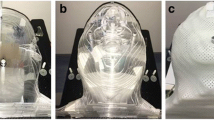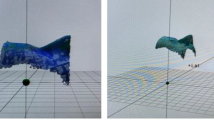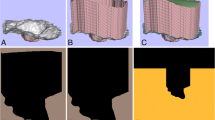Abstract
Purpose
The objective of this work is to estimate the patient positioning accuracy of a surface-guided radiation therapy (SGRT) system using an optical surface scanner compared to an X‑ray-based imaging system (IGRT) with respect to their impact on intracranial stereotactic radiotherapy (SRT) and intracranial stereotactic radiosurgery (SRS).
Methods
Patient positioning data, both acquired with SGRT and IGRT systems at the same linacs, serve as a basis for determination of positioning accuracy. A total of 35 patients with two different open face masks (578 datasets) were positioned using X‑ray stereoscopic imaging and the patient position inside the open face mask was recorded using SGRT. The measurement accuracy of the SGRT system (in a “standard” and an SRS mode with higher resolution) was evaluated using both IGRT and SGRT patient positioning datasets taking into account the measurement errors of the X‑ray system. Based on these clinically measured datasets, the positioning accuracy was estimated using Monte Carlo (MC) simulations. The relevant evaluation criterion, as standard of practice in cranial SRT, was the 95th percentile.
Results
The interfractional measurement displacement vector of the SGRT system, σSGRT, in high resolution mode was estimated at 2.5 mm (68th percentile) and 5 mm (95th percentile). If the standard resolution was used, σSGRT increased by about 20%. The standard deviation of the axis-related σSGRT of the SGRT system ranged between 1.5 and 1.8 mm interfractionally and 0.5 and 1.0 mm intrafractionally. The magnitude of σSGRT is mainly due to the principle of patient surface scanning and not due to technical limitations or vendor-specific issues in software or hardware. Based on the resulting σSGRT, MC simulations served as a measure for the positioning accuracy for non-coplanar couch rotations. If an SGRT system is used as the only patient positioning device in non-coplanar fields, interfractional positioning errors of up to 6 mm and intrafractional errors of up to 5 mm cannot be ruled out. In contrast, MC simulations resulted in a positioning error of 1.6 mm (95th percentile) using the IGRT system. The cause of positioning errors in the SGRT system is mainly a change in the facial surface relative to a defined point in the brain.
Conclusion
In order to achieve the necessary geometric accuracy in cranial stereotactic radiotherapy, use of an X‑ray-based IGRT system, especially when treating with non-coplanar couch angles, is highly recommended.










Similar content being viewed by others
References
Kuntz L, Le Fèvre C, Jarnet D et al (2022) Local recurrence and cerebral progression-free survival after multiple sessions of stereotactic radiotherapy of brain metastases: a retrospective study of 184 patients. Strahlenther Onkol 198(6):527–536. https://doi.org/10.1007/s00066-022-01913-6
Steinmann D, Vordermark D, Gerstenberg W et al (2020) Quality of life in patients with limited (1–3) brain metastases undergoing stereotactic or whole brain radiotherapy. Strahlenther Onkol 196(1):48–57. https://doi.org/10.1007/s00066-019-01506-w
Lai J, Liu J, Zhao J et al (2021) Effective method to reduce the normal brain dose in single-isocentre hypofractionated stereotactic radiotherapy for multiple brain metastases. Strahlenther Onkol 197(7):592–600. https://doi.org/10.1007/s00066-021-01757-6
Rades D, Hornung D, Blanck O et al (2014) Stereotactic radiosurgery for newly diagnosed brain metastases. Strahlenther Onkol 190(9):786–791. https://doi.org/10.1007/s00066-014-0625-1
Pallotta S, Vanzi E, Simontacchi G et al (2015) Surface imaging, portal imaging, and skin marker set-up vs. CBCT for radiotherapy of the thorax and pelvis. Strahlenther Onkol 191(9):726–733. https://doi.org/10.1007/s00066-015-0861-z
Li S, Geng J, Williams J et al. (2000) A novel 3D-video-based refixation technique for fractionated stereotactic radiotherapy. In: Proceedings of the 22nd Annual International Conference of the IEEE Engineering in Medicine and Biology Society (Cat. No.00CH37143). IEEE, p 2693
Nguyen D, Farah J, Barbet N et al (2020) Commissioning and performance testing of the first prototype of AlignRT InBore™ a Halcyon™ and Ethos™-dedicated surface guided radiation therapy platform. Phys Med 80:159–166. https://doi.org/10.1016/j.ejmp.2020.10.024
Freislederer P, Kügele M, Öllers M et al (2020) Recent advances in Surface Guided Radiation Therapy. Radiat Oncol. https://doi.org/10.1186/s13014-020-01629-w
Hoisak JD, Pawlicki T (2018) The Role of Optical Surface Imaging Systems in Radiation Therapy. Semin Radiat Oncol 28(3):185–193. https://doi.org/10.1016/j.semradonc.2018.02.003
Li Z, Xiao Q, Li G et al (2021) Performance assessment of surface-guided radiation therapy and patient setup in head-and-neck and breast cancer patients based on statistical process control. Phys Medica 89:243–249. https://doi.org/10.1016/j.ejmp.2021.08.007
Laaksomaa M, Sarudis S, Rossi M et al (2019) AlignRT® and Catalyst™ in whole-breast radiotherapy with DIBH: Is IGRT still needed? J Appl Clin Med Phys 20(3):97–104. https://doi.org/10.1002/acm2.12553
Stanley DN, McConnell KA, Kirby N et al (2017) Comparison of initial patient setup accuracy between surface imaging and three point localization: A retrospective analysis. J Appl Clin Med Phys 18(6):58–61. https://doi.org/10.1002/acm2.12183
Rigley J, Robertson P, Scattergood L (2020) Radiotherapy without tattoos: Could this work? Radiography 26(4):288–293. https://doi.org/10.1016/j.radi.2020.02.008
Carl G, Reitz D, Schönecker S et al (2018) Optical Surface Scanning for Patient Positioning in Radiation Therapy: A Prospective Analysis of 1902 Fractions. Technol Cancer Res Treat 17:153303381880600. https://doi.org/10.1177/1533033818806002
Kügele M, Mannerberg A, Nørring Bekke S et al (2019) Surface guided radiotherapy (SGRT) improves breast cancer patient setup accuracy. J Appl Clin Med Phys 20(9):61–68. https://doi.org/10.1002/acm2.12700
Hattel SH, Andersen PA, Wahlstedt IH et al (2019) Evaluation of setup and intrafraction motion for surface guided whole-breast cancer radiotherapy. J Appl Clin Med Phys 20(6):39–44. https://doi.org/10.1002/acm2.12599
Pazos M, Walter F, Reitz D et al (2019) Impact of surface-guided positioning on the use of portal imaging and initial set-up duration in breast cancer patients. Strahlenther Onkol 195(11):964–971. https://doi.org/10.1007/s00066-019-01494-x
Reitz D, Walter F, Schönecker S et al (2020) Stability and reproducibility of 6013 deep inspiration breath-holds in left-sided breast cancer. Radiat Oncol. https://doi.org/10.1186/s13014-020-01572-w
Heinzerling JH, Hampton CJ, Robinson M et al (2020) Use of surface-guided radiation therapy in combination with IGRT for setup and intrafraction motion monitoring during stereotactic body radiation therapy treatments of the lung and abdomen. J Appl Clin Med Phys 21(5):48–55. https://doi.org/10.1002/acm2.12852
Sarudis S, Karlsson A, Bäck A (2021) Surface guided frameless positioning for lung stereotactic body radiation therapy. J Appl Clin Med Phys 22(9):215–226. https://doi.org/10.1002/acm2.13370
Covington EL, Popple RA (2021) A Low-Cost Method to Assess the Performance of Surface Guidance Imaging Systems at Non-Zero Couch Angles. Cureus. https://doi.org/10.7759/cureus.14278
Covington EL, Fiveash JB, Wu X et al (2019) Optical surface guidance for submillimeter monitoring of patient position during frameless stereotactic radiotherapy. J Appl Clin Med Phys 20(6):91–98. https://doi.org/10.1002/acm2.12611
Zhao B, Maquilan G, Jiang S et al (2018) Minimal mask immobilization with optical surface guidance for head and neck radiotherapy. J Appl Clin Med Phys 19(1):17–24. https://doi.org/10.1002/acm2.12211
Lee SK, Huang S, Zhang L et al (2021) Accuracy of surface-guided patient setup for conventional radiotherapy of brain and nasopharynx cancer. J Appl Clin Med Phys 22(5):48–57. https://doi.org/10.1002/acm2.13241
Covington EL, Stanley DN, Fiveash JB et al (2020) Surface guided imaging during stereotactic radiosurgery with automated delivery. J Appl Clin Med Phys 21(12):90–95. https://doi.org/10.1002/acm2.13066
Peng JL, Kahler D, Li JG et al (2010) Characterization of a real-time surface image-guided stereotactic positioning system. Med Phys 37(10):5421–5433. https://doi.org/10.1118/1.3483783
Perks JR, Jalali R, Cosgrove VP et al. (1999) Optimization of stereotactically-guided conformal treatment planning of sellar and parasellar tumors, based on normal brain dose volume histograms. International Journal of Radiation Oncology*Biology*Physics 45(2): 507–513. https://doi.org/10.1016/S0360-3016(99)00156‑X
Smyth G, Evans PM, Bamber JC et al (2019) Recent developments in non-coplanar radiotherapy. BJR 92(1097):20180908. https://doi.org/10.1259/bjr.20180908
Zhang S, Yang R, Wang X (2019) Dosimetric quality and delivery efficiency of robotic radiosurgery for brain metastases: Comparison with C‑arm linear accelerator based plans. J Appl Clin Med Phys 20(11):104–110. https://doi.org/10.1002/acm2.12746
Schmitt D, Blanck O, Gauer T et al (2020) Technological quality requirements for stereotactic radiotherapy. Strahlenther Onkol 196(5):421–443. https://doi.org/10.1007/s00066-020-01583-2
Lutz W, Winston KR, Maleki N (1988) A system for stereotactic radiosurgery with a linear accelerator. International Journal of Radiation Oncology*Biology*Physics 14(2): 373–381. https://doi.org/10.1016/0360-3016(88)90446‑4
Verellen D, Linthout N, Bel A et al. (1999) Assessment of the uncertainties in dose delivery of a commercial system for linac-based stereotactic radiosurgery. International Journal of Radiation Oncology*Biology*Physics 44(2): 421–433. https://doi.org/10.1016/S0360-3016(99)00020‑6
Takakura T, Mizowaki T, Nakata M et al (2010) The geometric accuracy of frameless stereotactic radiosurgery using a 6D robotic couch system. Phys Med Biol 55(1):1–10. https://doi.org/10.1088/0031-9155/55/1/001
Bry V, Licon AL, McCulloch J et al (2021) Quantifying false positional corrections due to facial motion using SGRT with open-face Masks. J Appl Clin Med Phys 22(4):172–183. https://doi.org/10.1002/acm2.13170
Lawrence YR, Li XA, el Naqa I et al (2010) Radiation Dose-Volume Effects in the. Brain Int J Radiat Oncol 76(3):20–S27. https://doi.org/10.1016/j.ijrobp.2009.02.091
Minniti G, Clarke E, Lanzetta G et al (2011) Stereotactic radiosurgery for brain metastases: analysis of outcome and risk of brain radionecrosis. Radiat Oncol. https://doi.org/10.1186/1748-717X-6-48
Jhaveri J, Chowdhary M, Zhang X et al (2019) Does size matter? Investigating the optimal planning target volume margin for postoperative stereotactic radiosurgery to resected brain metastases. JNS 130(3):797–803. https://doi.org/10.3171/2017.9.JNS171735
Funding
The investigation was supported by Brainlab AG and C‑RAD AB. Brainlab contributed financially to the additional costs of the open mask project and C‑RAD provided the SRS module for the CatalystTM HD free of charge.
Author information
Authors and Affiliations
Corresponding author
Ethics declarations
Conflict of interest
M. Schöpe, J. Sahlmann, S. Jaschik, A. Findeisen and G. Klautke declare that they have no competing interests.
Additional information
Publisher’s Note
Springer Nature remains neutral with regard to jurisdictional claims in published maps and institutional affiliations.
Supplementary Information
66_2023_2170_MOESM1_ESM.pdf
Comparison of patient setup accuracy for optical surface-guided and X‑ray-guided imaging with respect to impact on intracranial stereotactic radiotherapy
Rights and permissions
Springer Nature or its licensor (e.g. a society or other partner) holds exclusive rights to this article under a publishing agreement with the author(s) or other rightsholder(s); author self-archiving of the accepted manuscript version of this article is solely governed by the terms of such publishing agreement and applicable law.
About this article
Cite this article
Schöpe, M., Sahlmann, J., Jaschik, S. et al. Comparison of patient setup accuracy for optical surface-guided and X-ray-guided imaging with respect to the impact on intracranial stereotactic radiotherapy. Strahlenther Onkol 200, 60–70 (2024). https://doi.org/10.1007/s00066-023-02170-x
Received:
Accepted:
Published:
Issue Date:
DOI: https://doi.org/10.1007/s00066-023-02170-x




